I have found in the past that no sooner have I planted a new plant , than there it is , all over the garden, sometimes this is an asset, especially when doing a new border, all the empty spaces fill in no time. Also the books and magazines tell us that it is good to have a linking theme round the whole of the garden.There are times however, when a firm hand is needed to sort things out. A plant that is welcome anywhere it chooses is Verbena bonariensis, this seeds about on my heavy clay, but it is never a problem. Only one plant was bought, but now it has spread through a couple of borders. Each year I wonder if I have lost it over the winter, but by summer time, there it is once more, keeping the bees and butterflies happy.
The purple leafed form of Anthricus (Angelica) looked wonderful the first year, after that we had seedlings everywhere in the border smothering smaller plants. I now dead head it before it can go to seed, hoping to prevent a population explosion.
Many years ago, as I have already mentioned in previous posts, I grew some Verbascum from seed, yellow and white, for at least 10 yrs there has been nothing, but this year they have both grown again. Has the seed been lying dormant in the soil, I can’t think of any other explanation of why they should suddenly appear in almost the same spot again. They are both very welcome and this year I am saving the seed.
A friend gave me a plant of Feverfew when I was making the garden, it has now spread everywhere and is sacrificed whenever I need to find a space for a new more interesting plant. There will always be plenty left in the garden as it does form a linking theme between the borders.
Being on heavy clay soil that has had loads of extras added to it to help with the drainage, I still wasn’t sure that Erigeron karvinskianus would be happy, I was right , it died. But not before it set seed and decided that life between the paving slabs by the house wall was just where it wanted to be.More seedlings have popped up between the paving and they have been moved to other places, some survive, some don’t, I’m just grateful that a few do.
Digitalis comes in all shapes and sizes, and are so easy to grow from seed if you want to grow some of the more unusual ones. Only one plant of each is bought and soon you can have hundreds if that is your desire.
Can someone tell me the name of this rush like plant?I was given one when starting the garden and always seem to have a few, here and there. It is lovely for flower arranging.
Another one that was given to me that would be useful for flower arranging, Malva moschata alba. It is a lovely plant and there are a few plants of it in most of the sunny borders. It is never a nuisance and I think the seeds survive going through our compost so it appears wherever that is spread.
The same must have happened to this Sedum. Everything tells me that it likes to be in the sun in well drained soil, these appeared in the shade in permanently damp soil over the underground stream!
What can I say about Alchemilla mollis, it is everywhere!! Each year I dig out at least half of my plants, each year I deadhead before the seed is dropped, and each year it has spread more than ever. No more will ever go near my compost ever again, it’s off to the Council composting from now on, their compost is heated to a much higher temperature than mine so the seeds should be killed off!!
A bulb that spreads nicely is the Colchicum, I started with 5 bulbs and now have well over 50 which I now move to different parts of the garden just when the leaves are dying down in early summer.
Ants are responsible for moving the seed of Cyclamen round the shady parts of the garden. My original few corms are now huge but there are lots of smaller ones growing from where the seed has been dropped.
The birds are spreading the seed of Arum italicum marmoratum round the garden, not too much, I’m so pleased when I find more of it.
Evening Primrose is another plant that has its feet well and truly under the table, I think it is trying for a take over bid. Serious editing takes place each spring of all the seedlings that I think are surplus to requirements. Bees and moths love it and goldfinches come for the seed in the winter, I do have a soft spot for it but sometimes have to be firm.
Sometimes of course plants arrive all by themselves and make themselves at home. I wouldn’t be without the plain ordinary Linaria, it looks so lovely throughout various borders, but where did it come from?
I did buy the pink version, Lunaria Canon Went, on a couple of occasions, but both times it died. Many years later it started appearing in a couple of places all by itself, great!
Poppies have appeared in various forms over the years, I have sprinkled seed of the double pink but only get a few each year.
This small white one appeared in the vegetable garden one year, I now have it down near the house where I can see it all the time.
Another that suddenly appeared was this fringed red one, I have saved seed and hope to spread it a bit in another border.
Most of them are this lilac colour, very pretty,but now we are getting too many, don’t think I need to save any seed of this one, they spread themselves without any help from me.
Michlemas daisies are now making themselves too much at home, they arrived from nowhere and seem very happy. Every time I go to cut them down to stop them seeding, they are covered with bees, hoverflies, butterflies etc and the secateurs get put away once more.
A white one has arrived to join its blue friend, the wildlife loves it just as much.
Maybe I’m too soft hearted, maybe lazy, but whatever it is, I feel the garden benefits from all these plants that obviously feel happy here. Looking down the list of plants that have made themselves at home here, it dawned on me that most of them are ones that bring the bees, butterflies and other beneficial insects into the garden, and for that reason alone they are welcome to stay – would you weed them all out?


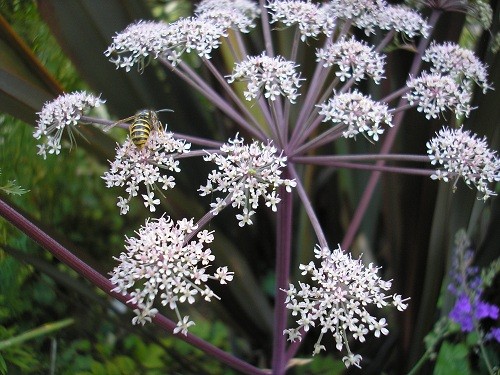

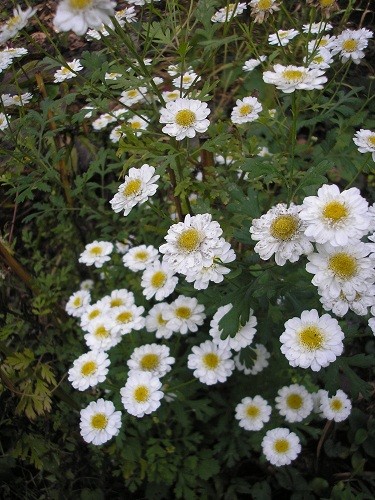
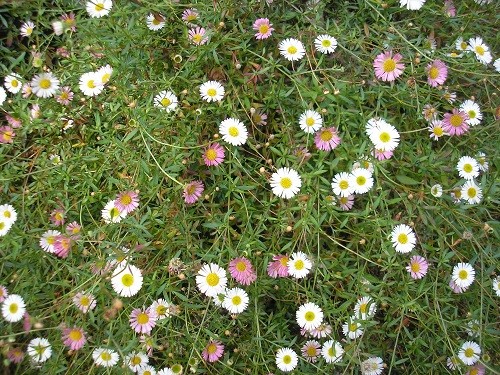

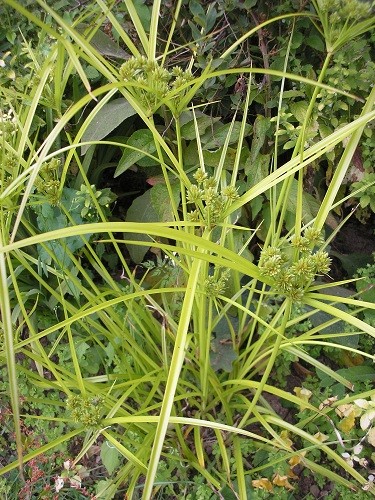

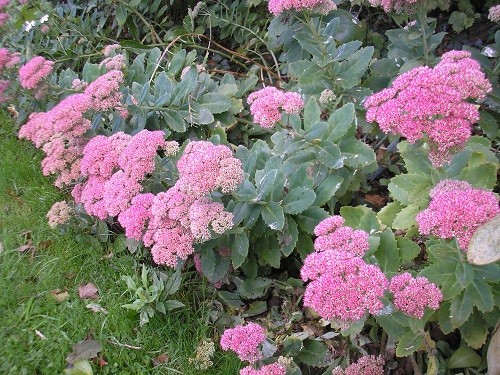


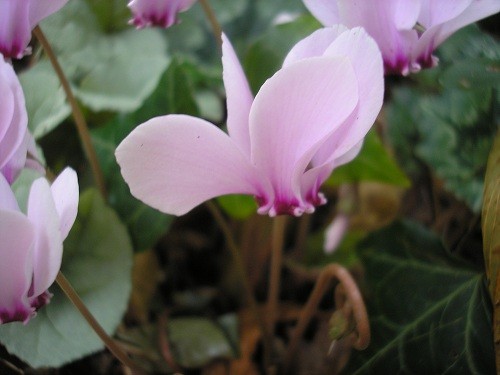



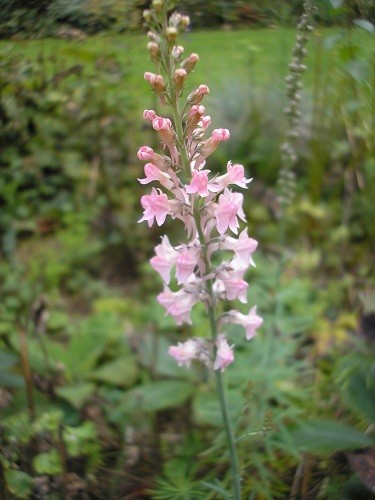




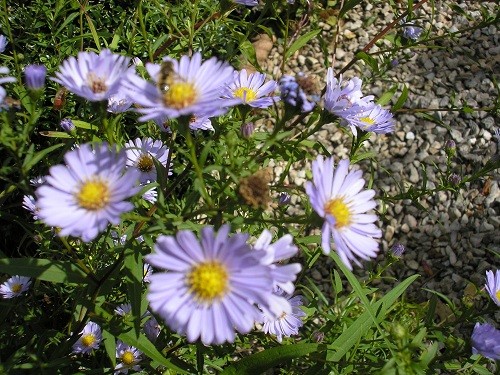

no Pauline I would not weed them out except for some neccessary editing of some, I had a feverfew but it died and didn’t set seed yet the golden feverfew seeds around, weird, beautiful blooms, I keep hoping for free plants and am learning more about division and seed, Frances
Glad to hear you agree with me Frances, I’m all for plants that cost me nothing. I’m not so successful with seeds sown in the greenhouse in seed trays or pots, but getting better with experience, the easiest I think is to scatter the hardy ones, then stand back and hope for the best.
Some of my best “design” decisions have been to leave a plant where it has seeded itself instead of trying to maintain control by pulling it out. Now I think hard before I remove any desirable self-seeding plant.
Glad we think alike Carolyn.sometimes nature finds just the right place to put its seeds, somewhere that we would never think to put them.
I love self seeders – and they can, as you say give a sense of unity – I am particularly fond of Verbena. I would love it if my Erigeron karvinskianus started to self seed around the place, although we are probably to wet here ….. unless it puts itself somewhere quite unexpected, that would be something to look forward to!
Softhearted, lazy – I dont think so, just managing with a gentle touch
🙂
K
Thank you Karen, so glad you like self seeders too. I was amazed when Erigeron placed itself at the base of the house wall, it looks so nice there, maybe there is lots of sand underneath the paving so it has bettter drainage than in the flower beds.
Quite right, the self seeders are the gardeners best friends. Verbena is all over my garden, it is never a problem, you can always compost the seedlings if they’re in completely the wrong place or better still share them with friends. I have very free draining of a very coarse texture so I’m surprised they seed so readily for you too. I envy you some of your other self seeders, though especially the asters and the Erigeron that should find places for itself easily, but hasn’t so far. Christina
Strangely Christina, Verbena seedlings always come up at the edge of the borders by the grass where all the rain water collects during the winter – doesn’t make sense does it?! Each spring ,I then have to move them further back before they start flopping everywhere.
Pauline, your self seeders are one better than the other… I am really envious!
I have verbena bonariensis popping up everywhere too, always welcomed, it’s colour is so nice and easy to mingle with every other colour in the garden…
I guess your rush like grass is a flat sedge (cyperus odoratus).
I’m soooooo envious of your purple angelica…
Thanks Alberto, I think we all love Verbena bonariensis and the bees and butterflies too!
Thank you for the help with the name of my sedge, so, not a rush as I thought.
Don’t be envious of the purple leaved angelica – that has to be well controlled, it puts down a long tap root and is difficult to remove when it has seeded into the middle of something precious.
Dear Pauline, that rush-like plant that you like is a terrible weed over here. I’m afraid I can’t remember its name, I’ve done a bit of a search but couldn’t find it. That’s the thing about gardening in different climates. As for self seeders, if they are not noxious weeds, I think they are wonderful. They decide where to be, and often create wonderful pictures that the gardener wouldn’t have thought of. Then we merely decide whether to let them stay or move, or remove them. cheers, c
As you say, Catmint, plants behave differently in different parts of the world, I’m glad my rush like plant behaves itself here otherwise it would have to go!